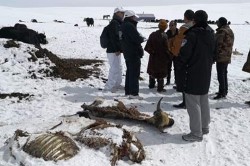Tibetet Segítő Társaság Sambhala Tibet Központ
Tibet Support Association Sambhala Tibet Center
székhely / telephely H-Budapest I. Attila út 123..
(00-36) 70 431 9343 (00-36)70 944 0260 (06-1)782 7721
sambhala@tibet.hu www.tibet.hu tibetpress.info
Facebook/Sambhala Tibet Központ Facebook/Tibett Segítő Társaság
MagnetBank/ 16200010-00110240
IBAN/HU94 16200010 00110240 00000000 SWIFT/HBWEHUHB
(1%) adószám/ 18061347-1-41
nyitva tartás/hétköznap 12.00-20.00 hétvégén előadás függő
» Retro» Tibeti művészet» Interjú» Levelek» Tibet Press» Tibet Press English» Dharma Press» Human Rights» Világ» Kína» Magyar» Ujgur» Belső-Mongólia » KőrösiCsoma» Élettér» Határozatok» Nyilatkozatok» tibeti művészet» lapszemle.hu» thetibetpost.com» eastinfo.hu» rangzen.net» ChoegyalTenzin» tibet.net» phayul.com» DalaiLama.com» vilaghelyzete.blogspot.com» Videók» Linkek» TibetiHírek» Szerkesztőség
A kínai professzor visszhangzza, hogy Kína nemzeti parkrendszere figyelmen kívül hagyta a helyi lakosok fontos szerepét
2019. szeptember 18./Phayul.com/TibetPress
By Tenzin Sangmo DHARAMSHALA, Sept. 18: A Chinese Professor has said the Chinese national park system ignored the important role played by local residents’ eco-friendly mode of production, joining other Chinese experts pointing out the reason behind China’s failure to protect Tibet’s environment.
DHARAMSHALA, Sept. 18: A Chinese Professor has said the Chinese national park system ignored the important role played by local residents’ eco-friendly mode of production, joining other Chinese experts pointing out the reason behind China’s failure to protect Tibet’s environment.
Professor Min Qingwen, deputy director of the Center for Natural and Cultural Heritage (CNACH) at Chinese Academy of Sciences, urged the government not to relocate farmers and nomads from protected areas and to instead address their livelihood and production problems to solve the larger problem of ecological protection.
In a report published on the website of the Chinese People’s Political Consultative Conference (CPPCC) early last month, Prof. Min was quoted as saying “in the process of developing national parks, park administrators focus only on the site of the protected area and ignore protection as the goal,” according to Tibetan Center for Human Rights and Democracy (TCHRD).
“Having lived there for generations, these farmers and herders have developed an ecological culture centered on protecting the nature and have long followed the traditional way of balancing agriculture and grassland use with ecological protection,” Professor Min continued.
Citing findings from his field studies and research, Min noted that Local Tibetans have an inherent capacity to act as effective ecological managers and recounted a recent example from the Sanjiangyuan area where the first national park is set to open in 2020.
“Recently when there were severe snowstorms and heavy snowfall in the Sanjiangyuan area making it difficult for wild animals to forage for food and water, local residents such as lay people and the monks came forward and spontaneously organized the transportation of fodder for the starving wild animals. If such an emergency or unexpected situation occurs, a handful of administrators cannot be depended upon to handle the situation.”
The Sanjiangyuan (Chinese for ‘Source of Three Rivers’) area covers large parts of Kyegudo (Ch: Yushu), Golok (Ch: Guoluo), Tsolho (Ch: Hainan) and Malho (Ch: Huangnan) Tsonub (Ch: Haixi) Mongol and Tibetan Autonomous Prefecture in Qinghai Province with over 90 percent of the area’s population being Tibetans.
He suggested that the government, under the premise of reasonable and efficient planning, should let the local residents live in the park so that the construction of national parks can be promoted and the living standards of the local residents can be improved steadily.
Min further suggested that while due importance should be attached to the national park management model with Chinese characteristics, attention must be paid to protecting the excellent traditional culture of local residents and not simply copy experiences of foreign countries.
“The internationally advanced thinking on environmental protection and China’s national conditions determine that humans and nature cannot be separated and management of humans should become part of ecosystem management.”
TCHRD avers that Professor Min’s assessment largely corresponds with its 2015 special report on the travails of Tibetan herders, ‘Wasted Lives: China’s Campaign to End Tibetan Nomadic Lifeways’, authored by Australian development specialist Gabriel Lafitte.
